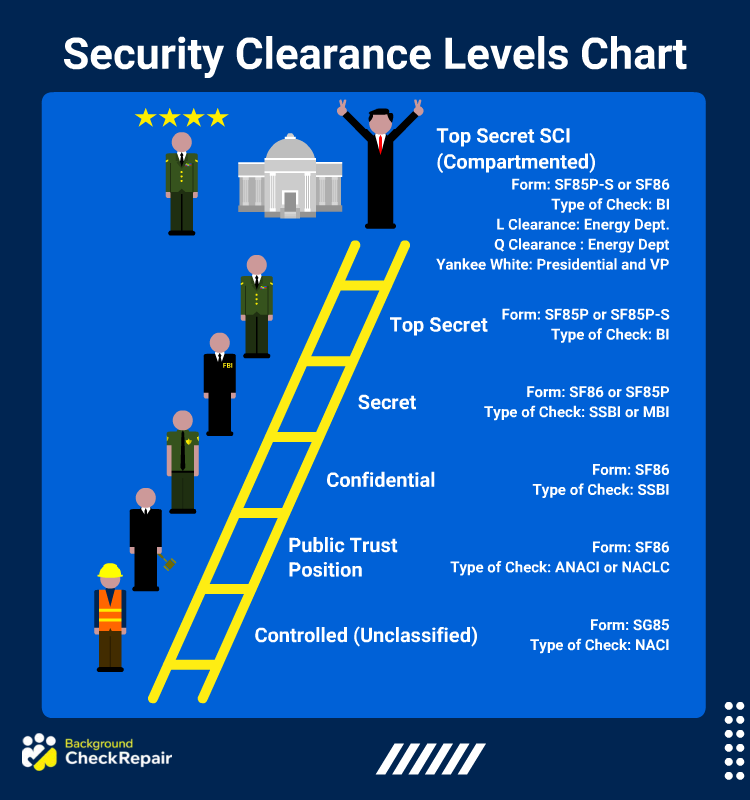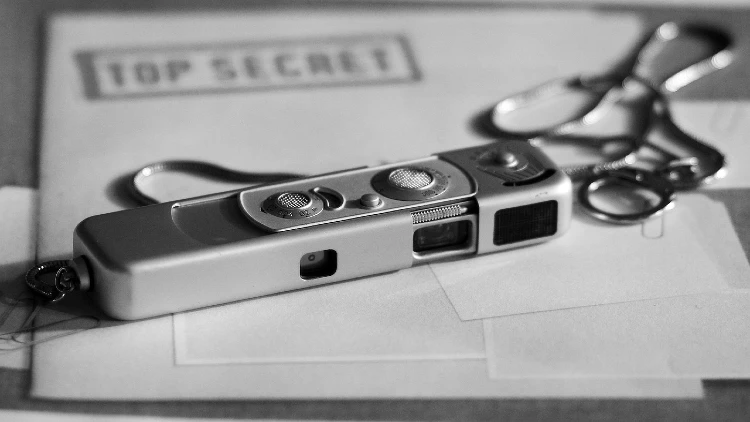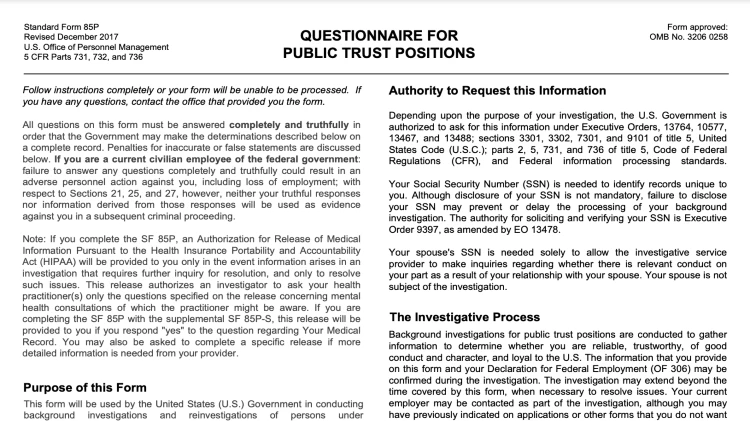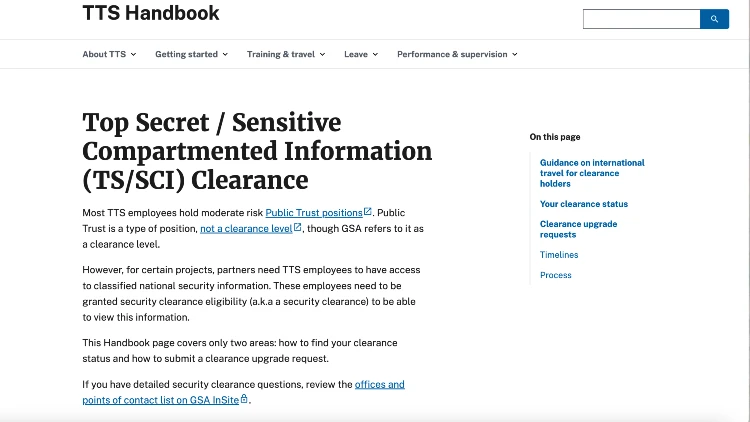
Anyone hoping to get a job with the federal government may be confused about the different security clearances that are issued, and having a security clearance levels chart can help them understand what to expect.
Luckily, the various official levels are not as complicated as they seem. Officially, the government outlines three levels of security clearance, confidential, secret, and top secret. However, that’s just the tip of the iceberg.
The security clearance levels chart below covers everything from minimal security all the way to the top including secret information on a compartmentalized situation.
Knowing and understanding these levels, as well as what disqualifies someone from clearance, can help many people who plan to undergo the background investigations outlined for each level.
Security Clearance Levels Chart: What Are the 5 Levels of Security Clearance?
One of the biggest causes of confusion amongst security clearances is precisely how many there are, which is what makes creating a security clearance levels chart somewhat difficult. Part of this confusion is due to different government agencies having their own security clearances in some cases.

Security clearances range in scope from basic Unclassified checks to Top Secret checks for the most sensitive of positions.
Generally speaking, there are 5 different levels of security clearance used by the federal government to determine the sensitivity of the information that an individual will have access to and how they should be screened to view this information. However, top-secret security clearance goes even further.
Federal Security/Suitability Clearance Chart
Keep in mind that the below security level clearance chart is intended as a guideline. There are plenty of exceptions to the various security clearances and much of the information that belongs to each section will be available only on a need-to-know basis.
Individuals with security clearance can not access every file that falls into that level, only ones that are relevant to their job.
Controlled (Unclassified): Level 1 Security Clearance
This is the lowest level of security clearance and will not allow access to sensitive information. This is the level that many government employees will be required to undergo. This primarily gives access to confidential information that does not have any real security risk involved.
Individuals with this security clearance will be able to access such information on a need-to-know basis.
Public Trust Position: Level 2 Security Clearance
The next level of security clearance will allow access to sensitive, but non-critical information.
This essentially means that although the information someone with this clearance could have access to could be harmful, the information is by no means an issue of national security should it fall into the wrong hands.
Confidential: Level 3 Security Clearance
At this level of security clearance, the amount of sensitive and valuable information that individuals could have access to begins to rise significantly. Information found in this level of security clearance is often highly sensitive and could lead to issues of national security if mishandled. Critical, national, and security information are all included in this level.
Secret: Level 4 and Level 5 Security Clearance
The fourth level of security clearance contains all of the previous information as well as information that is considered “special.” Information found at this level is highly secretive and will be restricted to an extremely low number of individuals.
Much of the information found in these levels will be the same as in the previous level. However, these levels also allow access to public trust information as well as secret information.
Top Secret: Level 6 Security Clearance and 5C Security Clearance
Although level 6 clearance does not allow access to more sensitive information than level 5, level 6 clearance usually includes public trust clearance and duties clearance which gives access to high-risk designated information. 5c security clearance refers to a position whose work is reviewed by a higher authority due to the high risk given the information involved.

(Image: Peter Wiberg4)
These clearances require a single-scope background investigation (SSCI).
The security clearance levels chart listed above breaks down the security levels based on the type of security clearance background check investigation that is performed for each level. Since each level has access to different kinds of information, the investigation must be performed differently to protect the information.
Is There a Clearance Level Higher Than Top Secret?
Top secret is generally considered the highest level of clearance and the official highest level of clearance according to the federal government.1 Technically there is no higher level than a top-secret clearance. However, this does not mean that all individuals with top-secret clearance have access to the same information.
Generally, in any branch of the government that has sensitive information and requires individuals to have a security clearance in order to access certain materials, the individuals will only have access to certain information.
Even if their security clearance is high enough to access information, virtually all sensitive information beyond level 1 will require individuals to have a reason to access the information.
Individuals with top secret clearance can not simply comb through any file imaginable and instead will operate on a need-to-know basis making certain information permanently off-limits.
Security Clearance Levels Chart: What Is Ultra Top Secret Clearance?
Ultra top secret clearance is not used as an official term when it comes to sensitive information. However, most individuals refer to this term as the especially dangerous information in the secret clearance category which could cause grave danger to national security.
As mentioned the highest level of security clearance is top-secret, although there is likely some information that is limited to an extremely small group of individuals.
What Is Top Secret SCI Security Clearance?
Top secret SCI clearance is a security clearance designation that allows access to specific compartmentalized material within the top secret security clearance level. The “top secret,” part refers to the level of security clearance the individual has obtained.

(Image: Caleb Oquendo5)
SCI stands for Sensitive Compartmentalized Information. Since virtually all security clearance information is on a need-to-know basis, the SCI refers to the type of materials to which this individual will have access.
Why Are There Levels of Security Clearance?
Since all sensitive information is on a need-to-know basis, security levels exist in order to ensure that individuals are only able to access information that is relevant to their work and to limit the risk to national security. The higher up an individual is in a particular government field, the more information they will need to be aware of. This is the main reason that security levels allow access to all the levels beneath them as well.
To put it simply, an individual in charge of a weapons facility will need to know more than an individual who works in a limited capacity in the same facility.
This hierarchy also works to speed up the vetting process for security clearances. With the highest levels of security clearance requiring a background check process that can take 18 months in some cases, individuals who only need to access mildly sensitive information can complete the background check process in around 6 months.
Security Clearance Process
A background screening for a security clearance is essentially an extremely intensive background check. The same general principles as a regular pre-employment background check will apply: those performing the check are looking at as many different aspects as possible to determine if the individual is a liability. Whilst most jobs are concerned with financial liability and background checks are performed to avoid getting sued, government jobs are concerned with national security above all else.
The process starts out like a normal background check with basic identity verification, past employment verification, educational background verification, and a criminal history check. Once these basic checks are performed the next step is to conduct a series of tests and thorough reference checks.
Numerous interviews and tests will be conducted on the individual to help get an idea of the individual’s integrity and trustworthiness.
Secret Clearance Requirements (Security Clearance Requirements)
The security clearance requirements for those applying for positions that require a secret or top secret clearance are some of the most intensive of any job. The background check investigation for these positions is extremely unique and thorough and can take up to 18 months to complete.
Unlike traditional background checks that rely on online databases to find information about individuals, the background check required to gain secret clearance requires a much more hands-on approach. As with any background check, it will start with the standard criminal database checks at the state, federal and national levels. After the criminal history check, verification of basic facts such as past employers, education, address, and more.
When the regular checks are completed, the background check moves into the next phase which includes a series of tests to help judge the individual’s integrity and trustworthiness as well as extensive reference checks on the individual. While most people are familiar with the idea of a reference check, the checks performed during a security clearance check are fairly different.
Normally, the applicant would provide a list of individuals who can speak to the employer about their work ethic and integrity. The applicant would pick individuals that they knew well and ones that would be more likely to speak highly of them.
However, when it comes to secret clearance requirements, the agency being applied for will request the list themselves as well as conduct investigations beyond the individuals that were requested.
This means the reference checks that are being performed are not limited to individuals that will speak highly of the individual, rather the investigators will seek out individuals who have a negative opinion of the applicant in order to find out why. Individuals that the applicant has not had contact with for years such as former employers, ex-roommates, and romantic partners, etc. are all fair game for this investigation.
Beyond the reference checks, virtually every possible aspect of the applicant’s life will be investigated as well. Their family members, political ideologies, and even current romantic relationships will also be under scrutiny. The agency may also do a background check through social media accounts.
It can be somewhat difficult to say exactly what investigators are looking for in this situation, but generally, they will be looking at anything that could be an issue of national security. If the individual sympathizes with a foreign adversary on social media, has relations with individuals with extensive criminal records, or even if they are having extramarital affairs can all be reasons for clearance to be denied.
What Level of Security Clearance Do I Have?
Most individuals, even those that work in the federal government will not have clearance levels of any kind. Individuals who do have clearance access will likely have gone through a long process to obtain the clearance and will have a specific reason for the clearance being given that is related to their job duties.
Secret vs Top Secret Clearance
The difference between secret and top secret clearance is in the sensitivity of the information and the corresponding background checks being more intensive.
The State Department refers to secret clearance as dealing with information that could cause “serious damage to national security,” whereas top secret clearance can cause “grave damage to national security.”
5 Automatic Disqualifiers for Security Clearances
There are plenty of different things that investigators are looking for when it comes to granting security clearance access to an individual. And, among the most common disqualifiers for a federal job, security clearance goes a step further.
Although these reasons can vary widely, there are a handful of reasons that tend to be more common than others when it comes to denying security clearance.
Keep in mind that the above security clearance levels chart only refers to the different kinds of information available at each level, the following disqualifiers tend to apply to each level of security clearance.

(Image: U.S. Office of Personnel Management2)
- Non-allegiance to the U.S. – Not being a U.S. citizen will result in disqualification. The risk of giving someone with foreign allegiance security clearance is seen as simply far too great of a risk.
- Foreign Preference – Often uncovered during social media checks or reference checks, individuals displaying a preference for a foreign nation, especially if this nation is not friendly toward the U.S. will result in disqualification.
- Risky Sexual Behavior – Risky sexual behavior is seen as a sign of low integrity and will usually result in disqualification. It also leaves individuals more vulnerable to blackmail.
- Untrustworthy personal conduct – The integrity of the individual is one of the primary things investigators will be examining. Lying on an application, even if on something small can be cause for disqualification.
- Poor financial standing – Being in poor financial standing leaves individuals vulnerable to blackmail and bribery.
What Disqualifies You From Public Trust Clearance?
Whereas with security clearance investigations integrity is one of many important factors that investigators will be examining, in public trust positions it is the primary factor. Individuals who lie on their application about employment history or education, drug use, etc. will be disqualified from public trust clearance.2
MBI Clearance vs Public Trust: What Is the Difference?
MBI clearance stands for minimum background investigation. This means that while the individual may work for the DOJ and be around somewhat sensitive materials, the individual will not need to access confidential or higher materials. Thus a full security clearance background investigation is not necessary.
A public trust clearance is a general term used to refer to a handful of basic background check procedures to ensure the individual is trustworthy enough to handle basic materials at high or moderate risk levels.
Top Secret Clearance Requirements
The requirements to obtain top-secret clearance are fairly extreme.3 The investigation is extremely intense due to the high stakes of hiring the wrong individual.

(Image: TTS Handbook3)
Unfortunately, many things outside of the individual’s control can cause them to be disqualified from Top secret clearance permanently. In short, it is very difficult to even for the most up-standing citizen to achieve top secret clearance.
DOD Security Clearance Levels Chart
Generally, the DOD security clearance levels are referred to as confidential, secret, and top secret. The DOD security clearance levels are the same as the security clearance hierarchy used by most of the federal government. However, the DOD will also conduct its own investigation for individuals seeking security clearance if their job duties require them to examine confidential, secret, or top-secret materials that are related to national defense.
Trying to understand the different levels of security clearance and what each one entails can be extremely confusing. However, not all of it is as complicated as it seems and individuals can use the security clearance levels chart to get a better idea of what each level means and what is required.
Frequently Asked Questions About Security Clearance Levels Chart







